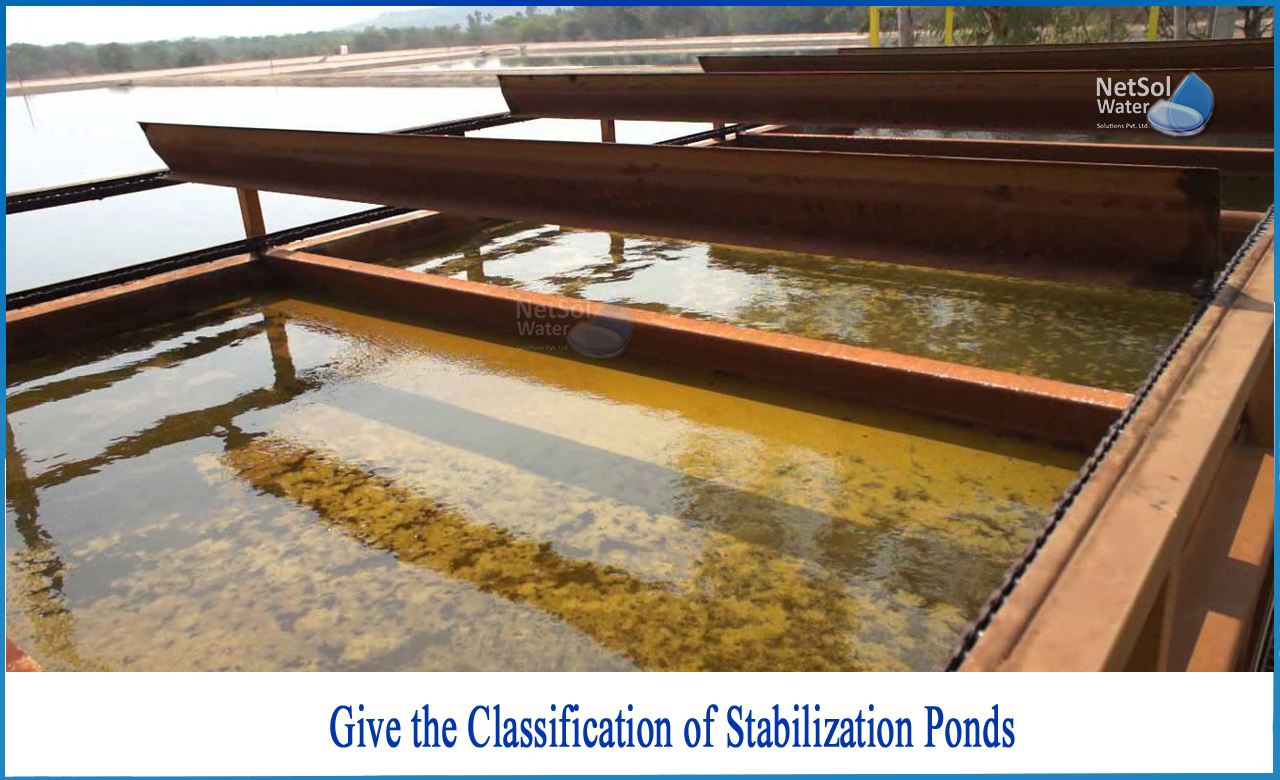How to classification of Stabilization Ponds?
Stabilization ponds are often categorized as follows based on the biological activity that occurs in them:
1. Aerobic.
2. Anaerobic.
3. Facultative Ponds.
1. Algae Ponds or Aerobic Ponds
The aerobic ponds (also known as algal ponds) are intended to keep the environment entirely aerobic. Natural surface aeration and algae photosynthesis provide oxygen to these ponds. The ponds are maintained shallow, ranging in depth from 0.5 to 1.2 meters. Shallower depths promote the development of rooted aquatic plants, but deeper depths might obstruct mixing and oxygen transmission from the surface.
How are Aerobic Ponds used?
An aerobic pond with a shallow depth (depth 0.15 to 0.45 m) is used to treat irrigation return water or any other industrial wastewater with the goal of removing nitrogen through algae bloom. For the treatment of household sewage, however, the depth is limited to 1 to 1.2 meters. The pond's length to breadth ratio is determined by the land's geometry, however it should not exceed 3:1. Short circuiting is less likely as a result of this.
The influent and effluent structures are strategically placed to make use of the total pond volume. The pond's contents are sometimes agitated to keep the settled muck from becoming anaerobic. Apart from the algal population, the microbial population in these ponds is comparable to that seen in activated sludge.
The aerobic population, which stabilizes the organic waste by oxidizing it, receives essential food from the daily flow of sewage carrying organic material. Ammonia, carbon dioxide, and other compounds are released during the oxidation process, which are needed by the algal population to proliferate and generate new algal cells.
2. Anaerobic Ponds
The whole depth of anaerobic ponds is anaerobic, with the exception of a very thin top layer. The presence of dissolved oxygen in the water is not required for anaerobic microorganisms to operate. Their needs are satisfied by the oxygen that is chemically present in organic things.
T?he anaerobic decomposition process is divided into two stages, each of which is interconnected:
Step-1:Acid-producing bacteria decompose dissolved organic waste into organic acids such as acetic, propionic, and butyric acids, and
Step-2: Methane-producing bacteria further decompose these acids to produce the end products of methane, carbon dioxide, and water.
Because the methane-producing bacteria are sensitive to the concentration of volatile acids, effective functioning of anaerobic ponds necessitates a balance between steps 1 and 2.
The anaerobic bio-system uses a part of the waste as a source of energy and for the production of new bacterial cells. As a result, sludge or solids accumulation is significantly less in the anaerobic systems. The anaerobic pond's contents are black in colour, which is a good indicator that the pond is working well.
3. Facultative Ponds
A mix of aerobic, anaerobic, and facultative microorganisms helps to stabilize sewage in facultative ponds. At the surface of the facultative ponds, aerobic conditions prevail, while anaerobic conditions prevail at the bottom. As a result, these ponds have characteristics of both aerobic and anaerobic ponds.The depth of facultative ponds is between 1 and 1.5 meters.
A facultative pond has three zones:
Zone 1:An aerobic zone at the top where aerobic bacteria and algae coexist in a symbiotic relationship;
Zone 2:An anaerobic zone at the bottom, where anaerobic bacteria aggressively breakdown deposited materials; and
Zone 3:A facultative zone located between the aerobic and anaerobic zones, which is partially aerobic and partly anaerobic and in which facultative microorganisms decompose organic materials.
The aerobic zone's effect is comparable to that observed in aerobic ponds, resulting in bacterial-algal symbiosis. Furthermore, the top aerobic layer works as an effective deterrent to pond odour development. Because the pond's depth prevents mixing, organic materials that drop to the bottom are left to decompose anaerobically.
In terms of BOD and bacterial elimination, this method of pond treatment is equivalent to those of traditional secondary treatment procedures such as trickling filters, activated sludge, and so on.
As a result, facultative ponds are best suited for and most usually utilized for sewage treatment.
Technical assistance and guidance
Netsol Water collaborates with a wide range of international organizations to tackle complicated problems by strategically integrating modern treatment technology with practical solutions. We are the leading name for manufacturers of water and wastewater treatment plants including Stabilization Ponds, and is known to be NO. 1 at solving complicated processes like nutrient removal.
Netsol Water is Greater Noida-based leading water & wastewater treatment plant manufacturer. We are industry's most demanding company based on client review and work quality. We are known as best commercial RO plant manufacturers, industrial RO plant manufacturer, sewage treatment plant manufacturer, Water Softener Plant Manufacturers and effluent treatment plant manufacturers. Apart from this 24x7 customer support is our USP. Call on +91-9650608473, or write us at enquiry@netsolwater.com for any support, inquiry or product-purchase related query.



